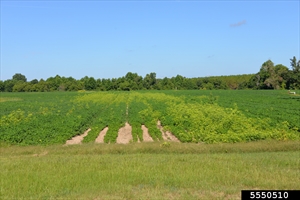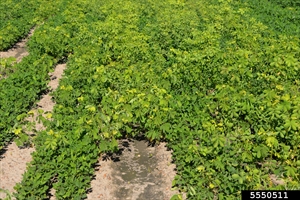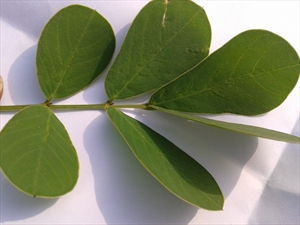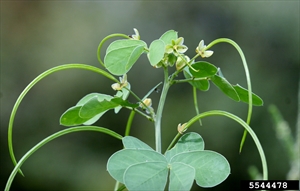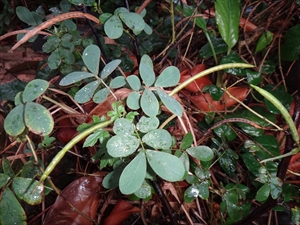Sicklepod. There have been many common names given to these two species, and this has caused some confusion. However, commonly Senna tora is called foetid cassia, or sickle senna, whereas Senna obtusifolia is called sicklepod, or Chinese senna. CABI prefers sicklepod for them both!
Pacific Pests, Pathogens, Weeds & Pesticides - Online edition
Pacific Pests, Pathogens, Weeds & Pesticides
Sicklepods (Senna species) (465)
Senna tora and Senna obtusiflolia. They were known previously as Cassia species. The two species are closely related, regarded by some as the same; however, others separate them by slight differences in shape and size, and the fact that seed between the two is mostly infertile. They are members of the Fabaceae.
Asia, Africa, North, South and Central America, the Caribbean, Europe (restricted), Oceania. It is recorded from Australia, American Samoa, Cook Islands, Federated States of Micronesia, Fiji, Guam, New Caledonia, Palau, Papua New Guinea, Samoa, Solomon Islands, Tonga, Tuvalu, and Vanuatu.
Senna tora probably has an origin from India to Polynesia. Senna obtusifloia is probably of tropical American origin.
These Senna species are invasive weeds creating continuous expanses (monocultures) in disturbed sites, waste areas, roadsides, waterways, pastures, agricultural crops, including plantations (coconut and sugarcane), in wetter tropical and sub-tropical countries, up to 1800 masl (Photos 1&2). They are suited to a range of soil types, with tolerance of dry soils.
Senna tora is the worst pasture weed of Vanuatu, and a major weed in Fiji and Tonga; it is also a problem in coconut plantations in Fiji and old plantations in Papua New Guinea. In Australia, it is a problem weed around sugarcane fields, creek flats and hilly grazing land. Senna obtusifolia is a major weed of peanuts and soybean in the USA.
Both species are relatively small, 50-150 cm tall, multiple-branching, erect shrubs, with strong tap roots, up to 1 m long. Leaves, 5-7.5 cm long, alternate along the stems; leaf stalks are 20-45 mm long, bearing 2-4 pairs of egg-shaped, opposite leaflets, 10-55 mm long and 10-35 mm wide, which have a rounded tip, narrower base, and tiny hairs at the margins (Photo 3). There is an elongated rod-like gland present between the lowest two pairs of leaflets (Photo 4). Crushing the leaves of Senna tora gives a strong unpleasant odour (hence the common name 'foetid'). Yellow flowers are borne on short stalks, 6-10 mm long, one or two in the leaf axils, mostly near the tips of the branches (Photos 5&6). Each flowers has five petals. and seven stamens (male parts), 1.5-2 mm long. Fruits, sickle shaped, 12-25 cm long and 2-6 mm wide, turning brown as they mature and curving downwards (Photo 7). Seeds shiny and flattened. Many thousands of seeds are produced per plant, and seeds may last up to 20 years in the soil.
As there are only minor differences in the leaves and the flowers between the two species, it is recommended that expert assistance is sought when making identifications. In the USA, different varieties of Senna obtusifolia exist.
Spread is by seed in water and by animals. The seeds survive passage through the guts of cattle, horses and goats that eat the fruit. Seeds are also spread in mud attached to animals, footwear, machinery or vehicles, or as a contaminant of fodder and pasture seeds.
Studies in the USA have found substantial yield reduction in cotton and soybean. For example, reports on cotton saw reductions in yield of 25% when Senna obtusifolia was at a density of about 1 plant per metre of row. In Australia, costs of chemical control are increasing in sugarcane as the area of Senna obtusifolia expands. There, too, the weed is reducing the carrying capacity of pastures and increasing costs in young forest plantations. In 1997, it was estimated that control costs were about $1 million a year in Queensland. Other impacts from these weeds are in protected areas where they have replaced native species in both Australia and the Galapagos Islands
Both species are alternative hosts of tobacco mosaic virus, and the fungus, Colletolricum capsici, which causes anthracnose of Solanaceous crops, particularly capsicum and chillies.
Senna tora and Senna obtusifolia are reportedly used in a number traditional medicines - as a source of vitamins, against ringworm and parasitic (helminth) worms, and more. The seed can also be used as substitute for coffee, and is a source of cassia gum used as a thickener in foods. Cattle will eat the weed in silage and also the dry seed pods. The leaves are high in protein and are also fed to poultry.
BIOSECURITY
The risk of introduction is high. Countries not yet infested should consider all likely pathways for entry, and apply quarantine measures accordingly. Particular attention should be given to the risks associated with the weeds as contaminants of pasture seed.
Sicklepods are among the 10 worst weeds in American Samoa, Tonga, and Vanuatu. In many countries, they are 'restricted invasive plants' under biosecurity acts. They are a restricted invasive plants under biosecurity acts in some parts of Australia; this means - a person must not release these invasive plants into the environment, give away or sell as a plant or something infested with its seeds.
BIOCONTROL
Alternaria cassiae, a fungus, has been formulated as a mycoherbicide in the USA for use in soybeans. However, there are reports of this fungus attacking cowpea in southern Africa, so risk assessments are needed when considering its introduction.
CULTURAL CONTROL
- Physical & Mechanical:
- Cultivation. Repeated discing can be used; it promotes germination and reduces the number of seeds in the soil, but is liable to spread the weed.
- Mulch. Grass (e.g., rye) has been used in soybeans and sunflower.
- Hand pulling. Possible, but has to be done early as the plant has a long tap roots which can regrow from the crown if it is not removed completely.
- Slashing. It is a methods that can be used in pastures to weaken the weeds and, with fertilizer and limited grazing, promote the development of grasses. It should be done before seed set.
- Exclusion:
- Restrict cattle and other livestock to areas as yet uninfested by the weeds. If stock is introduced from areas where mature seed are present, confine them to a small paddock for a week to ensure all seeds have been passed.
- Hygiene:
- Treat vehicles and farm machinery. If moving from areas where the weed occurs to those weed-free, wash to remove soil. This is equally important if the machinery is being imported into a country or moved within a country. Also, ensure seeds are not carried on clothes between infested and 'clean' areas.
CHEMICAL CONTROL
In Australia, 2,4-D (amine); 2,4-D + picloram; dichlorprop-p; triclopyr + picloram; dicamba, are registered for use against sicklepod. Note, herbicides are only effective on seedlings and new growth; this is because the outside layer of mature plants is thick and provides protection from herbicide action. In Fiji, glyphosate.
--------------------
Note, in the EU, and approval to use glyphosate ends in December 2022, but it was extended till 15 December 2023; its use after that date is under discussion.
____________________
When using a pesticide, always wear protective clothing and follow the instructions on the product label, such as dosage, timing of application, and pre-harvest interval. Recommendations will vary with the crop and system of cultivation. Expert advice on the most appropriate herbicides to use should always be sought from local agricultural authorities.
AUTHORS Grahame Jackson & Aradhana Deesh
Information from CABI (2019) Senna obtusifolia (sicklepod). Invasive Species Compendium. (https://www.cabi.org/isc/datasheet/49593); and DAF (2020) Sicklepods. Queensland Government. (https://www.daf.qld.gov.au/__data/assets/pdf_file/0013/51052/IPA-Sicklepod-PP18.pdf); and Waterhouse DF, Norris KR (1987) Cassia tora Linnaeus & Cassia obtusifolia Linnaeus. Biological Control Pacific Prospects. Inkata Press, Melbourne; and Senna tora (2020) Wikipedia. (https://en.wikipedia.org/wiki/Senna_tora); and Java bean (Senna tora) and Sicklepod (Senna obtusifolia) (2018) Weeds of SE Qld and Northern NSW. Lucidcentral. (https://www.lucidcentral.org/editors-pick-animal-and-plant-identification-keys/key-to-weeds-of-se-qld-and-northern-nsw); and from Senna obtusifolia (2019) Wikipedia. (https://en.wikipedia.org/wiki/Senna_obtusifolia). Photos 1&2 Joseph LaForest, University of Georgia, Bugwood.org. Photo 3 Nikitakamka Cassia_Tora_(young_plant). Photo 4 Dr. S. Soundarapandian Cassia tora. Photo 5 Nikitakamka Cassia_Tora (the seeds) (Wikipedia). Photo 6 Johnny N. Dell, Bugwood.org. Photo 7 Rebekah D. Wallace, University of Georgia, Bugwood.org.
Produced with support from the Australian Centre for International Agricultural Research under project HORT/2016/185: Responding to emerging pest and disease threats to horticulture in the Pacific islands, implemented by the University of Queensland, in association with the Pacific Community and Koronivia Research Station, Ministry of Agriculture, Fiji.
